Forum Replies Created
-
AuthorPosts
-
December 1, 2025 at 12:08 pm in reply to: Kingsbridge Burial Ground (aka Tippett/Betts/Berrian burial ground) #5076
Thanks, Nick, for your continuing efforts regarding the cemetery adjacent to the Van Cortlandt house.
I recall reading a description of the ground penetrating radar effort somewhere in the forum. Has it been determined exactly how many bodies are buried within the cemetery?
Has the Parks Department followed through with placing signage during the seven years since your request? Has any city condemnation record been found to substantiate the Parks Department claim to the cemetery grounds?
Has any further efforts of any kind been made regarding the cemetery since 2018? What efforts were made to preserve the headstones that were found behind the VC House?
Regarding the 1936 picture of the boy sitting between two headstones, it appears that the inscriptions were filled with a contrasting paint (?) that cannot be seen in the 1971 picture. Was this possibly due to weathering in the intervening 35 years? Who was the boy? Was he a descendant of the people buried there?
The journal describing the burial of Brigadier Buttler and the Hessian jäger is a good find.
Thank you, Blackbird1, for this information.
Regarding Cuthbert, I’m having a problem accepting the premise that the lawyer whose funeral took place on February 9, 1918 was the horticulturist who discovered the Cuthbert raspberry circa 1865.
What we know about a Thomas Newby Cuthbert is that he got an undergraduate degree in 1870 and a law degree in 1874, both from Columbia College and that he died on February 7,1918 (at the age of 68?).
We can assume that his age may have been 24 in 1874, making him only 15 at the time of discovery of the Cuthbert raspberry variant. It seems unlikely that a boy that young would have been that engrossed in horticulture. It seems logical to assume that it had been his father who was the horticulturist involved in the raspberry.
Any thoughts?
Thomas, this may be our subject’s son, Thomas W. Cuthbert who died on February 7,1918.
https://www.familysearch.org/ark:/61903/1:1:2W6M-CX4?lang=en
I just missed your post, Thomas. Sorry.
A Google search for Thomas N. Cuthbert resulted in 222 “relevant” returns, none of them being for our desired gentleman. Apparently, our man left no mark in the pages of history other than, briefly, for the red raspberry. Presumably he died and was buried, but no one seems to know precisely when or where. Was he the first CIA plant? lol
I was curious and so did a query with Duck.ad, Grok, and ChatGPT regarding Thomas N. Cuthbert. Although there was information, including that he immigrated from Scotland, there seems to be no public information regarding his life. Being Scottish, I thought that he might have been a member of the Riverdale Presbyterian Church but their records aren’t digitized it seems. Do you think that there is more about him in the KHS archives yet to be discovered?
Hopefully, this won’t become an overwhelming endeavor in dealing with the NYC Landmarks Preservation Commission and material selection for maintenance and longevity considerations and the selection of the installer, all while staying within budget. I was faced with similar decisions when I built my home in Mattituck and can appreciate the job ahead of you.
I looked up the original material used for the roof for Edgehill: wood shingles. Hopefully, the Commission won’t insist on that due to potential problems in later years. Good luck.Thank you, Nick, for your efforts.
The unique style and history of the building cries, demands a beautiful, substantial, long-lived roof. I’m suggesting the use of Engineered Slate (Synthetic Slate) as it has the appearance of natural slate with less weight and it is easier to install. It lasts up to 70 years and would be more aesthetically pleasing than the shorter-lived asphalt or asbestos shingles.
A cost comparison of shingle materials by Duck.ai reveals the following:
Material Cost per Sq. Ft. Labor Costs Longevity in Years
Asphalt $3-$5 $2-$5 15-30
Asbestos $5-15 $5-$10 30-50
Engineered
Slate $8-$20 $5-$10 40-70Natural
Slate $20-$35 $10-$20 75-200Of course, budgetary constraints will prevail and restrict the choice.
Anyway, that’s my two cents. 8^)
Good Luck!!
 The widening of Broadway beginning at W 239th Street north to about 6035 Broadway occurred circa 1952.
The widening of Broadway beginning at W 239th Street north to about 6035 Broadway occurred circa 1952.
The carousel may have been constructed circa 1917-1920. This blow-up shows construction occurring to the extreme left viewed under the north stairs to the train station. The photo is in the collection of the NY Public Library Digital Collection.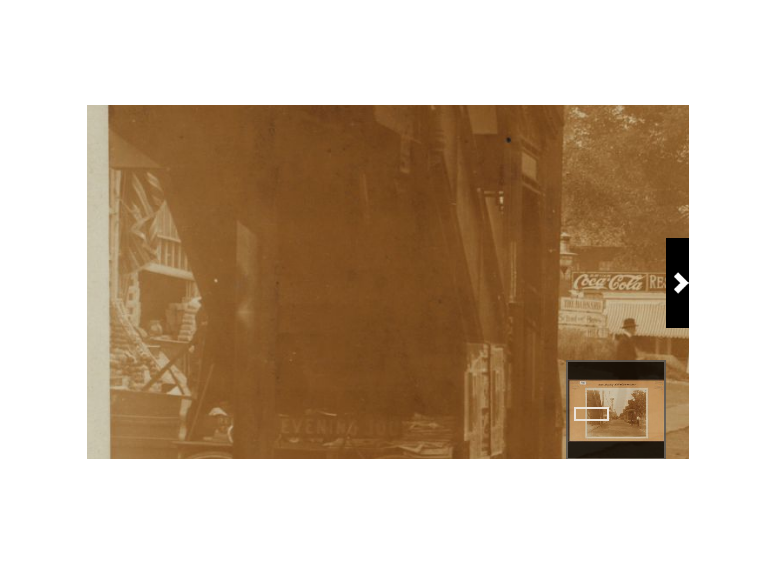
In the post #4992, the last picture seems to be taken from across Broadway looking toward VC House. I’m trying to place the photographer’s position. I’m wondering if he was standing on Old Post Rd behind the restaurant shown in these pictures that were taken around 1917 (from NY Public Library Digital Collection).
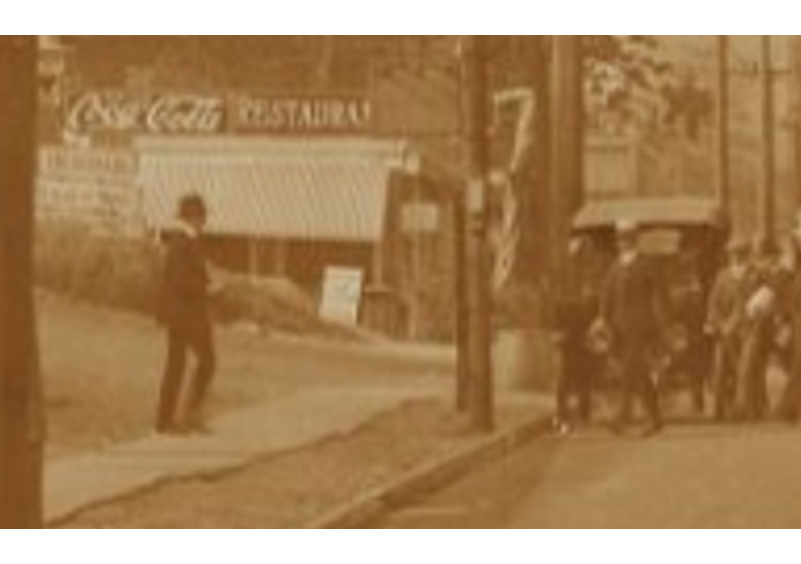
In the 1924 aerial view, the van Cortlandt House is in the blue circle, the approximate location of the Locust Grove is in the yellow oval, the Train Station is in the green rectangle and the location of the Old Mill is in the red oval.
The lack of trees in the yellow oval area would indicate that either many trees were felled or that there were few trees to begin with. What constitutes a “grove” might just be in the eyes of the beholder.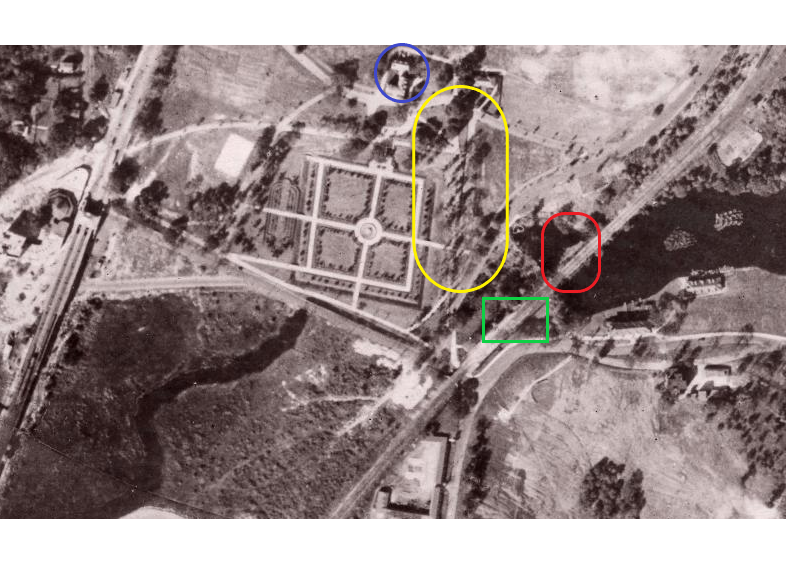
Following the description in Thomas’s article on “The Mill”, “It [the old mill] first stood just below the locust grove northwest of the van Cortlandt Station,”, I place the location approximately within the yellow oval. I show where I believe the old Mill stood in the red square for clarification. The train station is the green square.
I am perplexed that I don’t see either the van Cortlandt House to the rear, if the the photo was taken facing North, nor the train station, if the photo was taken facing South. Also, I can’t place the road with the street lights next to the path with anything in the area. The nearest street in that area is van Cortlandt Park road leading to the Boat House.
Further, the clothing worn by the people in the picture don’t seem to be turn-of the-century style, specifically, the lady’s skirt (unless I’m misinterpreting).
Thomas, you never cease to amaze me with your ability to offer relevant material. Thank you!
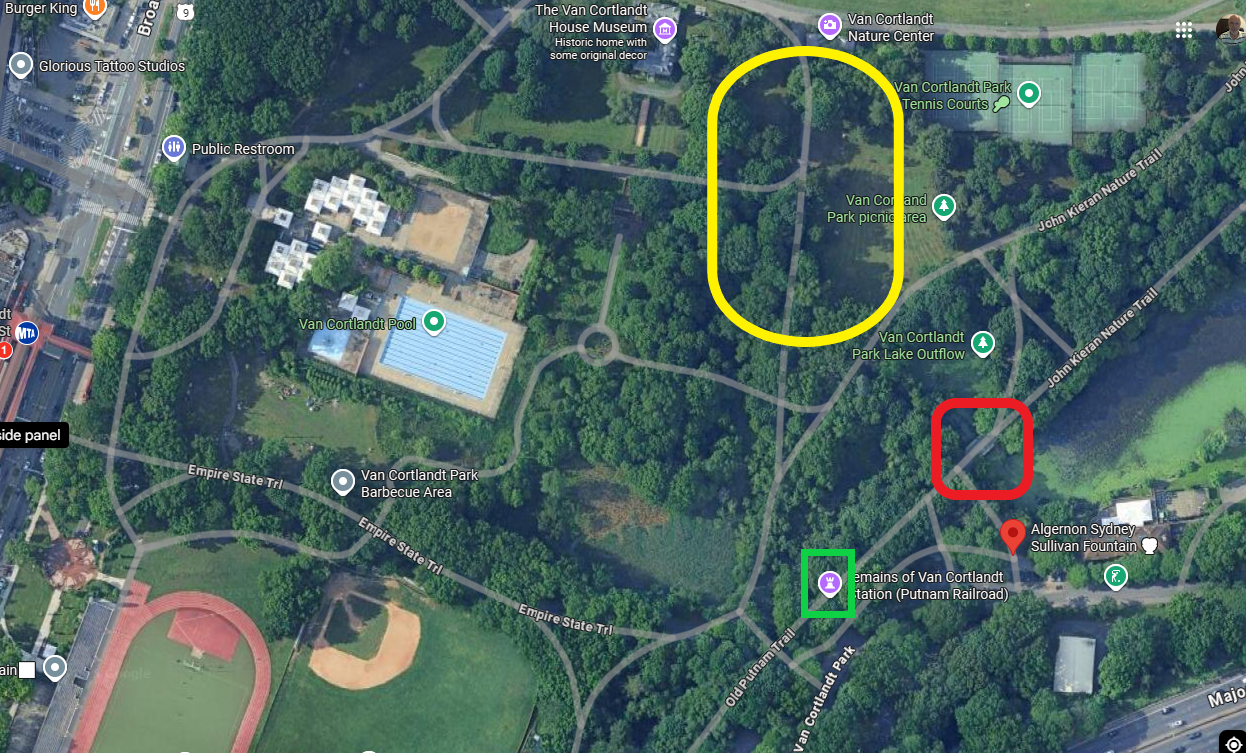
There are tennis courts to the east of the Museum House. Do you mean to the east of those, or between them and the Museum? There seems to be a road next to the path. Do you have a date for the photo in the postcard?
Here is a view taken in December 2024 of where the location of the Johnson house was, with a concrete retaining wall replacing the excavated stone ledge next to the house shown in the sepia photo.
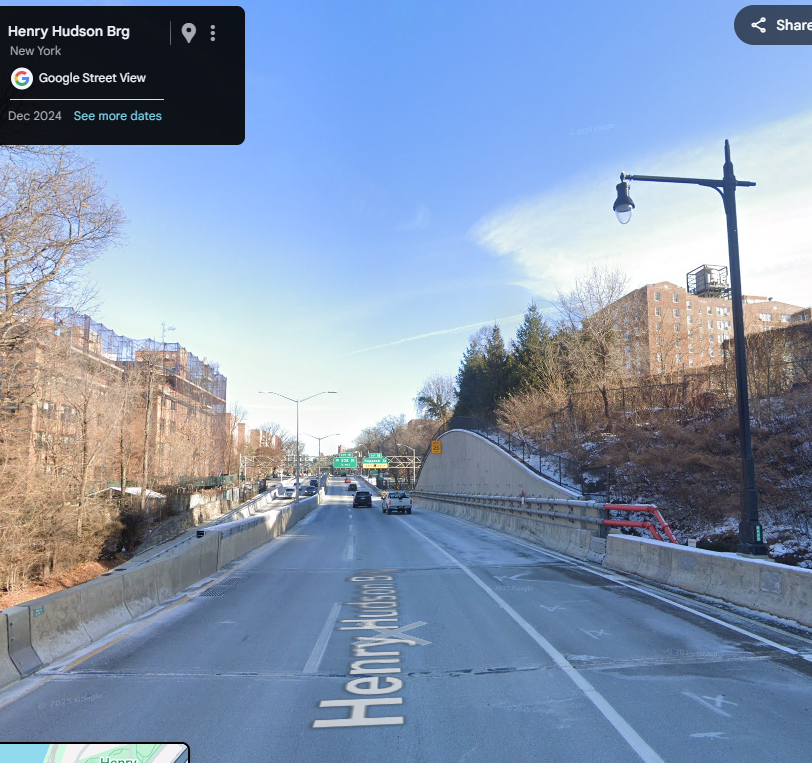
Thomas, are you referring to the house within the green hexagon? Nick identified the Johnson house that is next to the HHPkwy in the sepia photo. Your photo shows just how beautiful that house was. What a shame that it was torn down and, I think, replaced by a parking lot next to 55 Knolls Crescent.
tmara2, thank you for all this information! I hadn’t realized how close to the stables the old railroad line was. The picture brings into focus quite well the description Karl gave.
Philip LeStrange,
The station I referred to in my post 4897 was on the eastern, main line of the Putnam.
The photos I referenced in my post 4939 are, as Alan Lasky said, of the Van Cortlandt Station at the south end of VCP, before the track splits with a spur going toward Mosholu Ave and your station.
Perhaps this 1924 aerial view might show the location of the Mosholu Station.
The yellow line is Mosholu Ave that crosses Broadway and goes into VCP. The yellow circle may be the train station.
It looks as though one can drive into the Park on Mosholu Ave until reaching the stables, then there is a walking path that continues…perhaps all the way to where the station had been located.
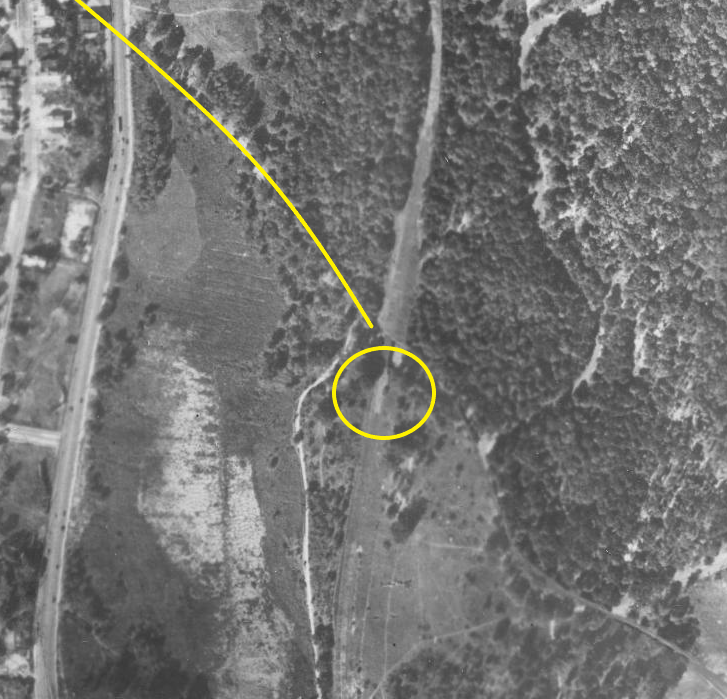
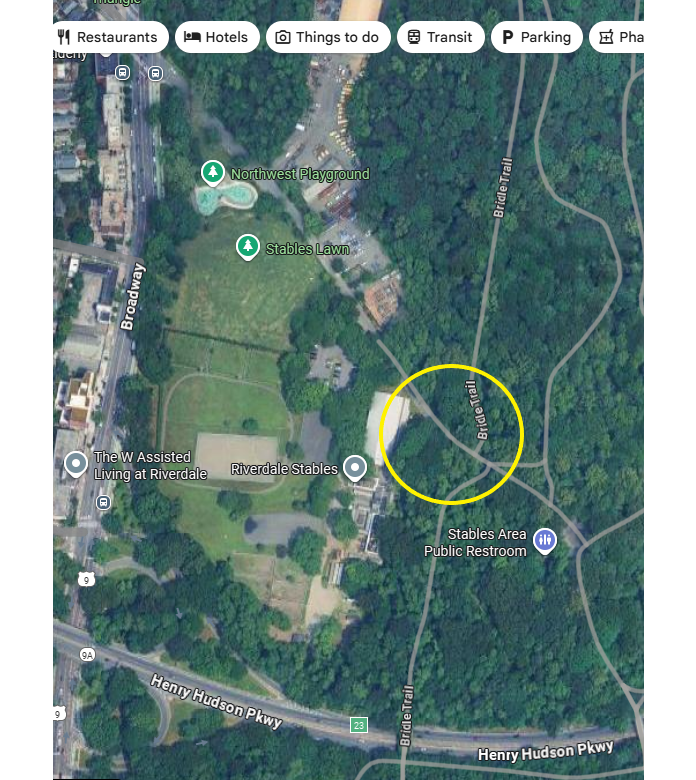
Karl, the red dots show 242nd street, the yellow line shows SDP and the yellow dots show the one-story buildings on the curve, one of which would house The French Bakery.
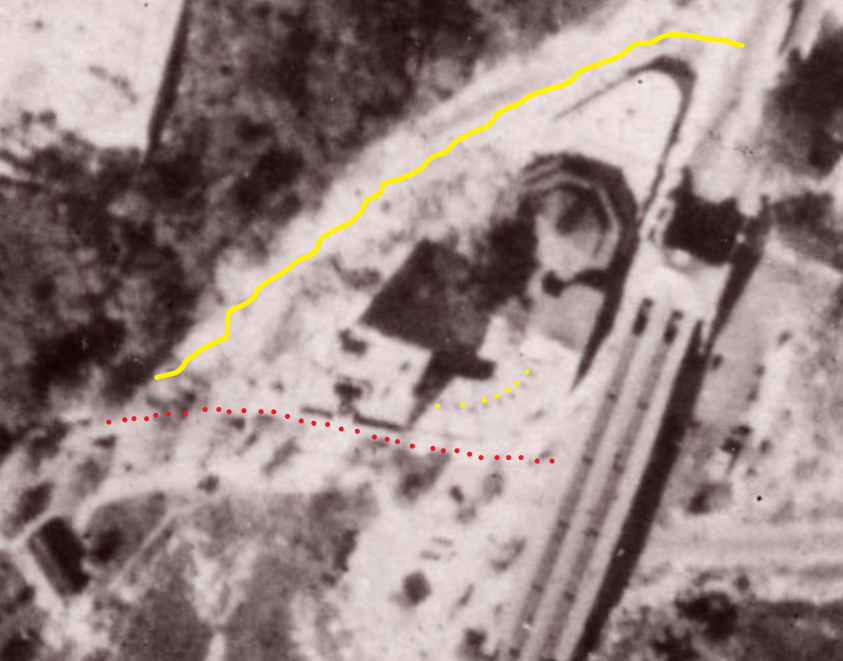
DWDitmars, thanks for these photos! The Old Stone House gives us a perfect “picture” of what it looked like. Do you have a date for the photo?
The pictures of the family on the porch show how “straight-laced” society was, and how uncomfortable it must have been in the summer without A/C. Moustaches were de rageux for the men as well as suits and ties and high collared blouses and maxi-skirts for the women. I’m breaking a sweat just thinking about it, lol.
Philip LeStrange,
Alan Lasky has posted some pictures of a Putnam train station that may be the one you are interested in. Search for 1468 and scroll down through the pictures until you reach the two that show the station.Closer examination of the aerial photo leads me to believe that my apartment building is not in the picture, at least not completely constructed. The orange shape is where my building should be in the year 1924, right next to 215 W 242nd St. that is shown and casts a shadow. The yellow line is Spuyten Duyvil Pkwy which should go right past 4652. Perhaps construction has just begun. The resolution isn’t good enough to say for sure. According to NYCityMap, both 4652 and 215 were built in 1923 and the Then & Now app claims the photo was shot in 1924. One of those two sources isn’t completely right. Frustrating.
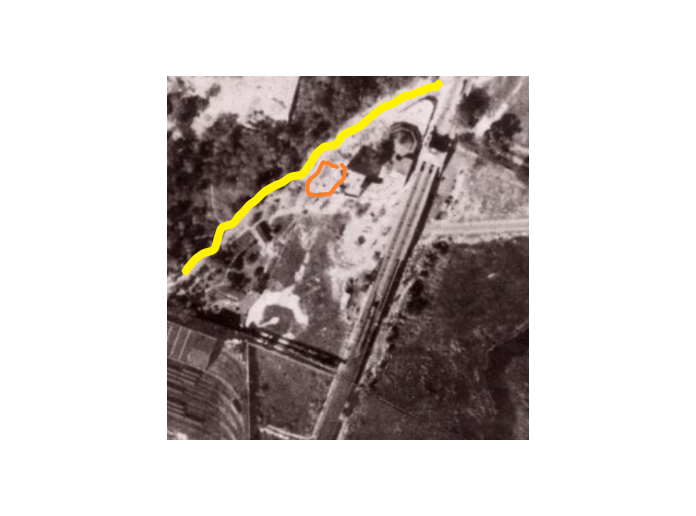
Karl,
According to NYCityMap 226 W 242nd Street was constructed in 1924. My building, 4652 Manhattan College Pkwy, was constructed in 1923.
I have a story about when I was a teenager and lived there. One afternoon after school I was in my room and heard loud voices. I looked out my bedroom window across to 226 and saw a fight going on in the top apartment between teenage brothers. One of the brothers was knocked against the window so hard that it broke the glass and the sash, He almost went out onto the street but luckily didn’t. I mean, he grabbed both sides of the window opening to prevent his falling. It was surreal. The picture shows my bedroom window in the black circle and the other bedroom window in red.I think that the name of the bakery was The French Bake Shop or maybe The French Bakery.
I was attending CCNY in the Fall of 1950 and then transferred to a college in North Carolina and was basically away until I got out of the Army in 1963. Prior to that we were neighbors 8^)
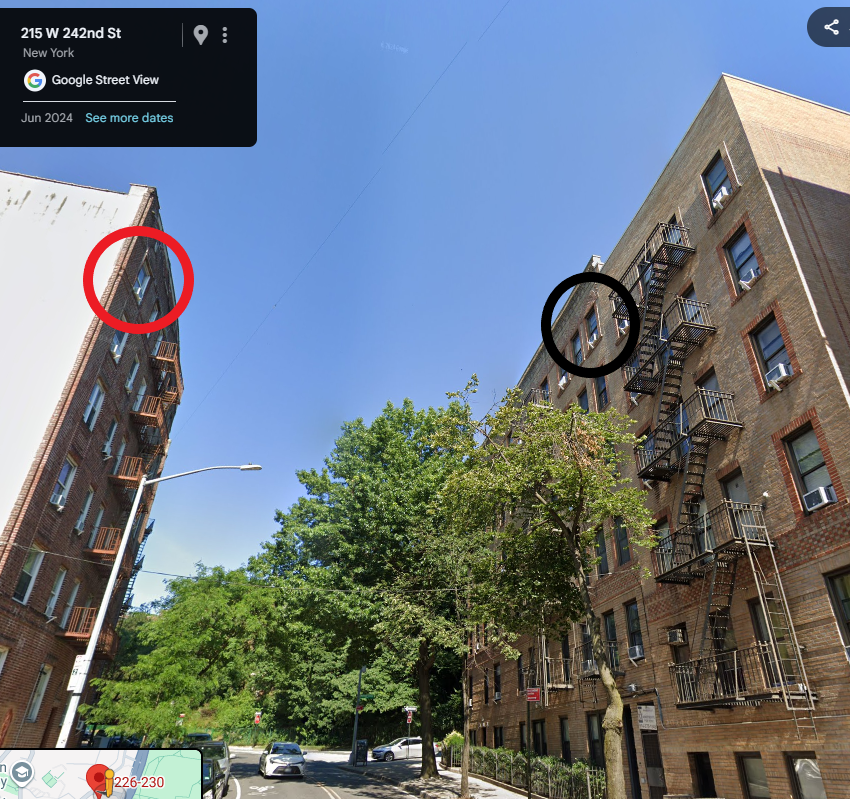
I’m wondering if the circled house is the Berrian-Johnson house.

Thank you Nick. From the photo it appears that the structure was razed subsequent to 7/17/1935 and prior to 1/6/1940, the date of the aerial photo (or did I overlook the house in the photo). My photo was dated circa 1940, so it may have been the last photo of the building as it stood in the Fall of 1939, I’m guessing. It looks like the property ended up being a parking lot next to 55 Knolls Crescent in the early 1950s. Sad.
Your second photo apparently was taken around 1902. Close inspection shows the words “Spuyten Duyvil” laid out on the embankment underneath the pedestrian overpass to the train station. I’m sure that they are all gone now, but can you identify any of the buildings on the hill to the left of the station?
I wonder what the story is of the boat the O.H. Notter (or Hotter, as best that I can make out). She doesn’t look seaworthy in the picture, lol.
ChatGPT estimates the population to be between 7,000 to 12,000 in 1940, depending on the boundaries chosen. Intuitively, that seems high.
-
AuthorPosts